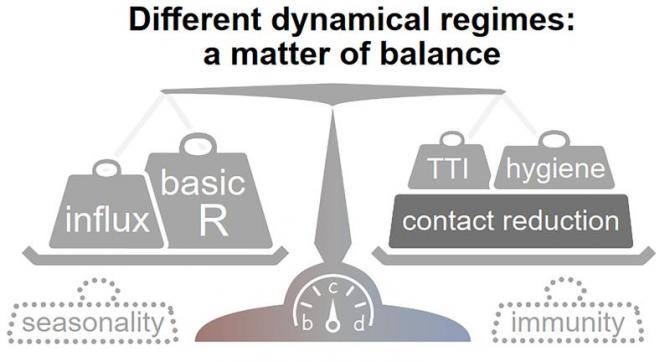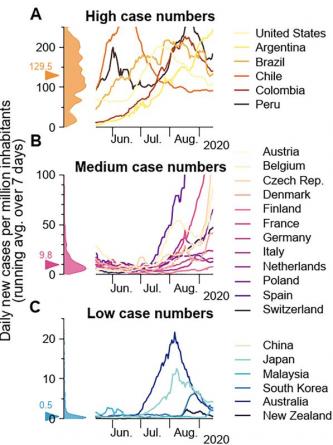newsletter
Individual behavior is important in the fight against the epidemic
by dr. Manuel Medorn
(05.11.2021) A new study in Science Advances analyzes how infectious disease outbreaks are contained. There it turns out that frequent strict lockdowns are not necessary for long-term control of epidemics – as long as moderate precautionary measures are maintained.
Photo Gallery
Researchers at the Max Planck Institute for Dynamics and Self-Organization (MPIDS) investigated the measures required under the circumstances in order to avoid such a strict lockdown. They conclude that individual behavior ultimately determines whether control of the pandemic can be maintained.
Sebastian Contreras of MPIDS, with colleagues, examined the control of disease spread through so-called non-pharmacological interventions. This includes both mandatory government measures and voluntary behavioral modifications such as physical distancing, daily habits and face masks. The researchers found that when the number of cases is low, freedom is maximized without the need for lockdowns. However, the critical factor in maintaining this freedom is to maintain a rapid and effective system of “trace and isolate” testing – that is, testing followed by contact tracing and quarantine in case of infection.
The Test-Trace-and-Isolate system has proven to be effective in breaking chains of infection.
During the COVID-19 pandemic, testing, tracing and isolating has made a major contribution to containing the spread of disease: by following close contacts of infected people, chains of infection can be broken. However, this approach is only effective if it is undertaken in a timely manner and if the numbers of cases are within the limited tracking capacity of the health authorities.
Researchers have found that through testing and contact, the incidence of COVID-19 can be stabilized at low levels and fewer measures are needed to protect the health of the population. However, this stability depends on the measures in place (voluntary and governmental) and the ability of health authorities to identify contacts; It is a matter of balance, as also shown in Figure 1.
“By analogy, a system of contact tracing and isolation to stop chains of infection is like that of firefighters who can fight wildfires: in both cases, it is much easier to contain outbreaks locally while they are still small. Once the outbreak is advised to get out of control, this strategy becomes slow It’s very unspecified; you have to take strong population-level measures again and at the same time try to protect people at risk,” says Viola Pressman, who coordinated the study. “Vaccines and other voluntary measures to prevent infection will make control easier and act like rain so comforting in our likeness to fire,” Sebastian Contreras adds.
The model confirms the evolution of the epidemic in the recent past
In addition to the new mathematical approach developed by the researchers, there are also examples from the past after the COVID-19 winter wave in 2020 that corroborate the results from the model (see Figure 2). However, the model deals with epidemics in general and is therefore also applicable to infectious diseases other than the COVID-19 pandemic. Thus, the results of the study enable policy makers to plan effective response strategies for the future. As a next step in their research, the scientists want to analyze the factors responsible for compliance with the measures by examining the interaction between disease spread and information.
Originalpublikation
https://www.science.org/doi/10.1126/sciadv.abg2243

“Total coffee aficionado. Travel buff. Music ninja. Bacon nerd. Beeraholic.”








More Stories
“His presence speaks powerfully.”
Experts informed patients about the topic of cervical cancer
'Gaia BH3': A massive black hole lurks here – a falling star that led to the discovery